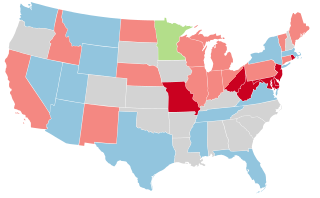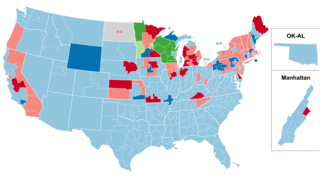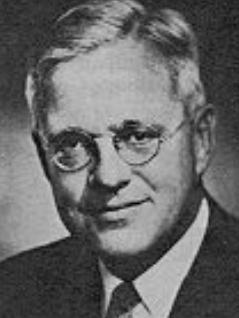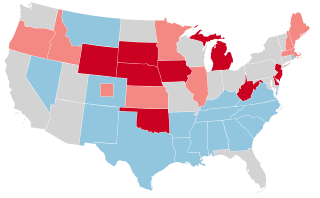Delaware became a U.S. state in 1787, which allowed it to send congressional delegations to the United States Senate and United States House of Representatives beginning with the 1st United States Congress in 1789. Voters in each state elect two senators to serve for six years, and members of the House to two-year terms. Before 1914 United States Senators were chosen by the Delaware General Assembly and before 1935 all congressional terms began March 4.

The 1936 United States Senate elections coincided with the reelection of President Franklin D. Roosevelt. The 32 seats of Class 2 were contested in regular elections, and special elections were held to fill vacancies. The Great Depression continued and voters backed progressive candidates favoring Roosevelt's New Deal in races across the country. The Democrats gained 5 net seats during the election, and in combination with Democratic and Farmer–Labor interim appointments and the defection of George W. Norris from the Republican Party to become independent, the Republicans were reduced to 16 seats. Democrats gained a further two seats due to mid-term vacancies. The Democrats' 77 seats and their 62-seat majority remain their largest in history.

The 1934 United States Senate elections were held in the middle of Democratic President Franklin D. Roosevelt's first term. The 32 seats of Class 1 were contested in regular elections, and special elections were held to fill vacancies. During the Great Depression, voters strongly backed Roosevelt's New Deal and his allies in the Senate, with Democrats picking up a net of nine seats, giving them a supermajority. Republicans later lost three more seats due to mid-term vacancies ; however, a Democrat in Iowa died and the seat remained vacant until the next election. The Democrats entered the next election with a 70-22-2-1 majority.

The 1928 United States Senate elections were elections that coincided with the presidential election of Republican Herbert Hoover. The 32 seats of Class 1 were contested in regular elections, and special elections were held to fill vacancies. The strong economy helped the Republicans to gain seven seats from the Democrats.

The 1922 United States Senate elections were elections that occurred in the middle of Republican President Warren G. Harding's term. The 32 seats of Class 1 were contested in regular elections, and special elections were held to fill vacancies. With the Republicans divided between conservative and progressive factions, the Democrats gained six net seats from the Republicans while the Farmer–Labor party gained one. The Republicans retained their Senate majority.

The 1934 United States House of Representatives elections were elections for the United States House of Representatives to elect members to serve in the 74th United States Congress. They were held for the most part on November 6, 1934, while Maine held theirs on September 10. They occurred in the middle of President Franklin D. Roosevelt's first term. The Democratic Party continued its progress, gaining another 9 net seats from the opposition Republican Party, who also lost seats to the Progressive Party. The Republicans were reduced below one-fourth of the chamber for the first time since the creation of the party. The Wisconsin Progressive Party, a liberal group which allied with the Democrats, also became a force in Wisconsin politics.

The 74th United States Congress was a meeting of the legislative branch of the United States federal government, composed of the United States Senate and the United States House of Representatives. It met in Washington, D.C., from January 3, 1935, to January 3, 1937, during the third and fourth years of Franklin D. Roosevelt's presidency. The apportionment of seats in the House of Representatives was based on the 1930 United States census.

Thomas Hopkinson Eliot was an American lawyer, politician, and academic who served as chancellor of Washington University in St. Louis and as a congressman in the United States House of Representatives from Massachusetts.
The Wyoming Democratic Party is the affiliate of the Democratic Party in Wyoming, headquartered in Cheyenne. The party was strong during Wyoming's territorial days, but suffered a decline in its early statehood. It rose to prominence again from the 1930s to the 1950s before experiencing another decline.

The Tenth Philippine Legislature was the meeting of the legislature of the Philippines under the sovereign control of the United States from 1934 to 1935.

The 1942 United States elections were held on November 3, 1942, and elected the members of the 78th United States Congress. In Democratic President Franklin D. Roosevelt's unprecedented third mid-term election and during World War II, the Republican Party picked up seats in both chambers. Still, the Democrats retained control of Congress.

The 1931 United States Senate special election in Vermont took place on March 31, 1931. Republican Warren Austin was elected to the United States Senate to serve the remainder of the deceased Frank L. Greene's term, defeating Democratic candidate Stephen M. Driscoll. Austin replaced Frank C. Partridge, who was appointed to fill the seat until a special election could be held and was defeated in the special primary.

The 1942 United States Senate election in Minnesota took place on November 3, 1942. Incumbent Republican Joseph H. Ball, who had been temporarily appointed by Governor Harold Stassen in 1940 to fill the seat of the deceased Farmer–Labor U.S. Senator Ernest Lundeen, defeated Farmer–Labor former U.S. Senator and former Governor Elmer Benson, independent candidate Martin A. Nelson, and Democratic nominee Ed Murphy, to win election to the full six-year term beginning in January 1943. A special election held on the same date elected Republican nominee Arthur E. Nelson to serve the remainder of Lundeen's unexpired term.

The 1936 United States Senate special election in Minnesota took place on November 3, 1936. The election was held to fill the vacancy in the seat formerly held by Thomas D. Schall for the final two months of Schall's unexpired term. Governor Floyd B. Olson had appointed Elmer Benson to fill the seat in 1935, but this appointment was temporary and subject to a special election held in the next general election year thereafter—1936. Benson opted to run for governor instead of running for election to continue for the remainder of the term. No special primaries were held for the special election. Among Minnesota's three major parties, only the Republican Party of Minnesota officially fielded a candidate—Guy V. Howard. Regardless of the absence of Farmer-Labor and Democratic nominees, Howard nevertheless faced a great degree of competition from independent candidates Nathaniel J. Holmberg, Andrew Olaf Devold, and John G. Alexander.

The 1936 United States Senate special election in Louisiana took place on April 21, 1936, to fill the remainder of the late former Senator Huey Long's six-year term. Long was first elected to the Senate in 1930 and was assassinated on September 10, 1935.

The 1936 Massachusetts gubernatorial election was held on November 3, 1936.

The 1936 Iowa State Senate elections took place as part of the biennial 1936 United States elections. Iowa voters elected state senators in 32 of the state senate's 50 districts. State senators serve four-year terms in the Iowa State Senate.

The 1934 Iowa State Senate elections took place as part of the biennial 1934 United States elections. Iowa voters elected state senators in 22 of the state senate's 50 districts. State senators serve four-year terms in the Iowa State Senate.














